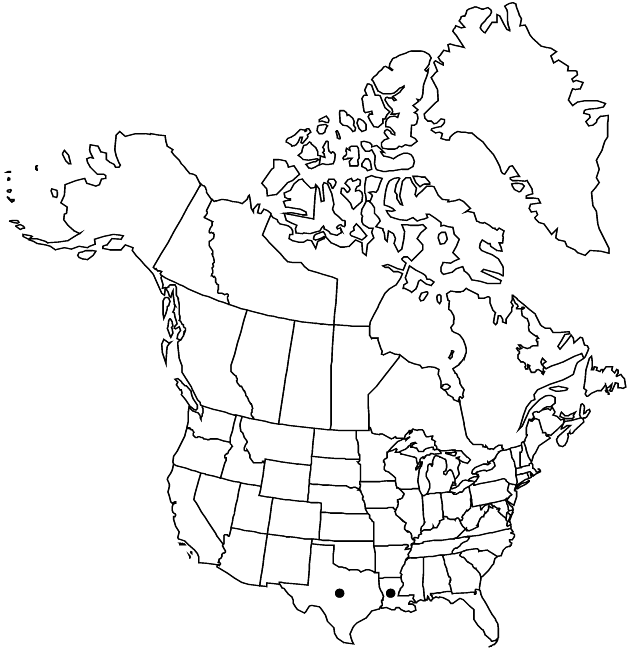Difference between revisions of "Berlandiera ×betonicifolia"
Fl. S.E. U.S., 1246, 1340. 1903.
FNA>Volume Importer |
imported>Volume Importer |
||
| (6 intermediate revisions by 2 users not shown) | |||
| Line 7: | Line 7: | ||
|year=1903 | |year=1903 | ||
}} | }} | ||
| − | |basionyms={{Treatment/ID/ | + | |basionyms={{Treatment/ID/Basionym |
|name=Silphium betonicifolium | |name=Silphium betonicifolium | ||
|authority=Hooker | |authority=Hooker | ||
| + | |rank=species | ||
| + | |publication_title=Compan. Bot. Mag. | ||
| + | |publication_place=1: 99. 1835 | ||
}} | }} | ||
|synonyms={{Treatment/ID/Synonym | |synonyms={{Treatment/ID/Synonym | ||
|name=Berlandiera pumila var. scabrella | |name=Berlandiera pumila var. scabrella | ||
|authority=G. L. Nesom & B. L. Turner | |authority=G. L. Nesom & B. L. Turner | ||
| − | }}{{Treatment/ID/Synonym | + | |rank=variety |
| + | }} {{Treatment/ID/Synonym | ||
|name=Berlandiera texana var. betonicifolia | |name=Berlandiera texana var. betonicifolia | ||
|authority=(Hooker) Torrey & A. Gray | |authority=(Hooker) Torrey & A. Gray | ||
| + | |rank=variety | ||
}} | }} | ||
|hierarchy=Asteraceae;Asteraceae tribe Heliantheae;Asteraceae (tribe Heliantheae) subtribe Ecliptinae;Berlandiera;Berlandiera ×betonicifolia | |hierarchy=Asteraceae;Asteraceae tribe Heliantheae;Asteraceae (tribe Heliantheae) subtribe Ecliptinae;Berlandiera;Berlandiera ×betonicifolia | ||
| Line 32: | Line 37: | ||
|elevation=50–200 m | |elevation=50–200 m | ||
|distribution=La.;Tex. | |distribution=La.;Tex. | ||
| − | |discussion=<p>In most characters, Berlandiera ×betonicifolia is intermediate between its parents (B. pumila and B. texana) in varying degrees and combinations. Drummond’s type (K) of Silphium betonicifolium resembles B. texana, to which it was assigned as a variety by J. Torrey and A. Gray (1838–1843), who commented that other specimens fitted neither varietal description completely. Artificially produced F1 offspring between extreme forms of the parents resemble closely Drummond’s type collection. Character states of S. betonicifolium that Hooker described in contradistinction to those of B. texana include longer petioles, less woody stems, and more ovate, hirsute leaves of membranous texture; and from B. pumila by the coarser and more deeply crenate margins, and peduncles with “beautiful jointed purplish hairs.” Artificially produced crosses between F1 hybrids and B. pumila resemble most of the field-collected B. ×betonicifolia specimens [called B. pumila (green form) by G. L. Nesom and B. L. Turner (1998)] because gene flow of B. ×betonicifolia is over a much greater geographic region of overlap with B. pumila than with B. texana.</p> | + | |discussion=<p>In most characters, <i>Berlandiera ×betonicifolia</i> is intermediate between its parents (<i>B. pumila</i> and <i>B. texana</i>) in varying degrees and combinations. Drummond’s type (K) of <i>Silphium</i> betonicifolium resembles <i>B. texana</i>, to which it was assigned as a variety by J. Torrey and A. Gray (1838–1843), who commented that other specimens fitted neither varietal description completely. Artificially produced F1 offspring between extreme forms of the parents resemble closely Drummond’s type collection. Character states of S. betonicifolium that Hooker described in contradistinction to those of <i>B. texana</i> include longer petioles, less woody stems, and more ovate, hirsute leaves of membranous texture; and from <i>B. pumila</i> by the coarser and more deeply crenate margins, and peduncles with “beautiful jointed purplish hairs.” Artificially produced crosses between F1 hybrids and <i>B. pumila</i> resemble most of the field-collected <i>B. ×betonicifolia</i> specimens [called <i>B. pumila</i> (green form) by G. L. Nesom and B. L. Turner (1998)] because gene flow of <i>B. ×betonicifolia</i> is over a much greater geographic region of overlap with <i>B. pumila</i> than with <i>B. texana</i>.</p> |
|tables= | |tables= | ||
|references= | |references= | ||
| Line 41: | Line 46: | ||
-->{{#Taxon: | -->{{#Taxon: | ||
name=Berlandiera ×betonicifolia | name=Berlandiera ×betonicifolia | ||
| − | |||
|authority=(Hooker) Small | |authority=(Hooker) Small | ||
|rank=species | |rank=species | ||
| Line 56: | Line 60: | ||
|publication year=1903 | |publication year=1903 | ||
|special status= | |special status= | ||
| − | |source xml=https:// | + | |source xml=https://bitbucket.org/aafc-mbb/fna-data-curation/src/2e0870ddd59836b60bcf96646a41e87ea5a5943a/coarse_grained_fna_xml/V19-20-21/V21_201.xml |
|tribe=Asteraceae tribe Heliantheae | |tribe=Asteraceae tribe Heliantheae | ||
|subtribe=Asteraceae (tribe Heliantheae) subtribe Ecliptinae | |subtribe=Asteraceae (tribe Heliantheae) subtribe Ecliptinae | ||
Latest revision as of 21:10, 5 November 2020
Plants to 110 cm. Stems (erect, flexible, sometimes suffrutescent) usually branched. Leaves evenly distributed along stems; petiolate; blades (at least at mid stem) narrowly to broadly ovate (widths 1/2–11/4 lengths), membranous, margins serrate to crenate or doubly crenate, faces finely hirsute to hispid (at least adaxial). Heads in paniculiform to corymbiform arrays. Peduncles hairy (hairs spreading to erect, relatively fine, curled). Involucres 12–18 mm diam. Ray corollas deep yellow to orange-yellow, abaxial veins green, laminae 9–18 × 5.4–9 mm. Disc corollas red to maroon. Cypselae (obovate) 2.5–4 × 4–5.5 mm. 2n = 30.
Phenology: Flowering Apr–Sep.
Habitat: Sandy-loamy soils, edges of or in woodlands of oak, pine, and/or hickory
Elevation: 50–200 m
Discussion
In most characters, Berlandiera ×betonicifolia is intermediate between its parents (B. pumila and B. texana) in varying degrees and combinations. Drummond’s type (K) of Silphium betonicifolium resembles B. texana, to which it was assigned as a variety by J. Torrey and A. Gray (1838–1843), who commented that other specimens fitted neither varietal description completely. Artificially produced F1 offspring between extreme forms of the parents resemble closely Drummond’s type collection. Character states of S. betonicifolium that Hooker described in contradistinction to those of B. texana include longer petioles, less woody stems, and more ovate, hirsute leaves of membranous texture; and from B. pumila by the coarser and more deeply crenate margins, and peduncles with “beautiful jointed purplish hairs.” Artificially produced crosses between F1 hybrids and B. pumila resemble most of the field-collected B. ×betonicifolia specimens [called B. pumila (green form) by G. L. Nesom and B. L. Turner (1998)] because gene flow of B. ×betonicifolia is over a much greater geographic region of overlap with B. pumila than with B. texana.
Selected References
None.
